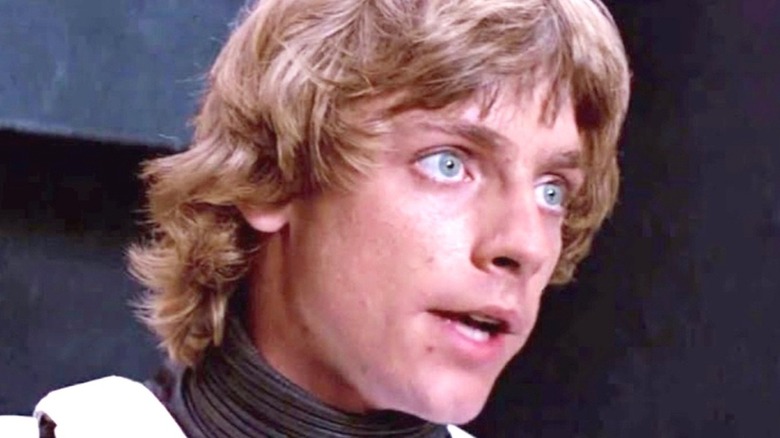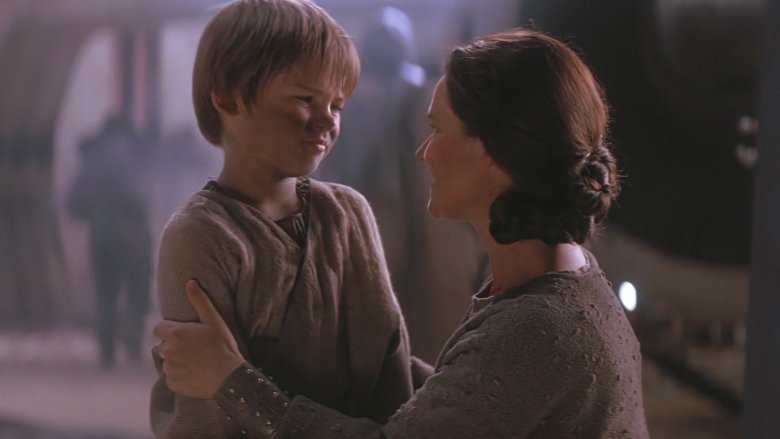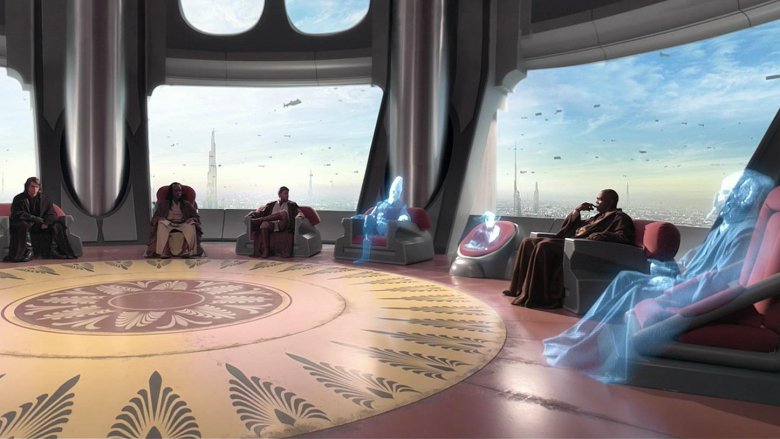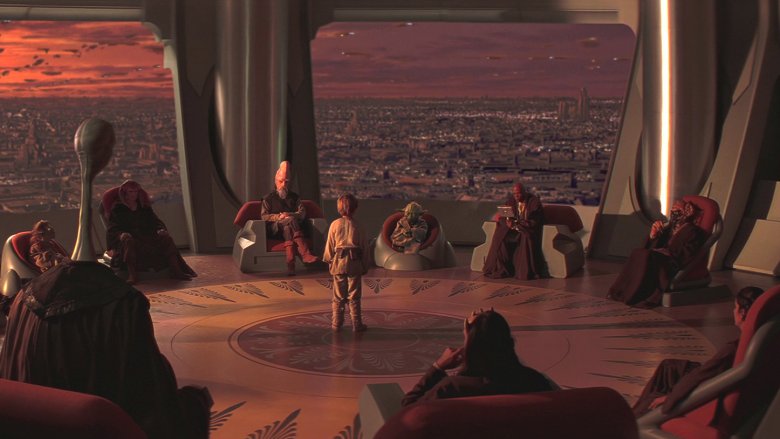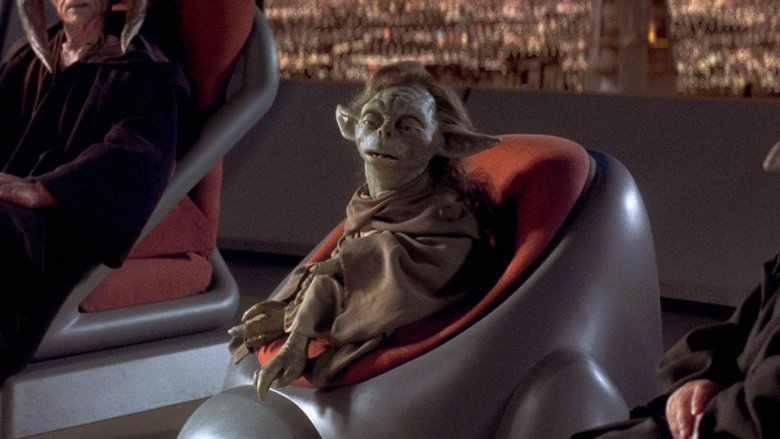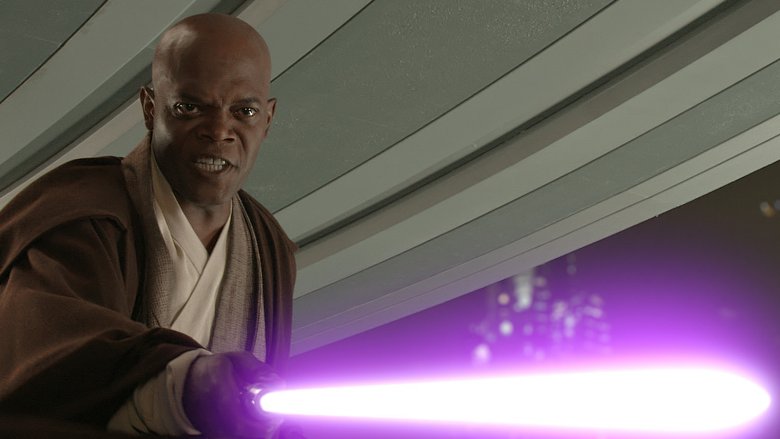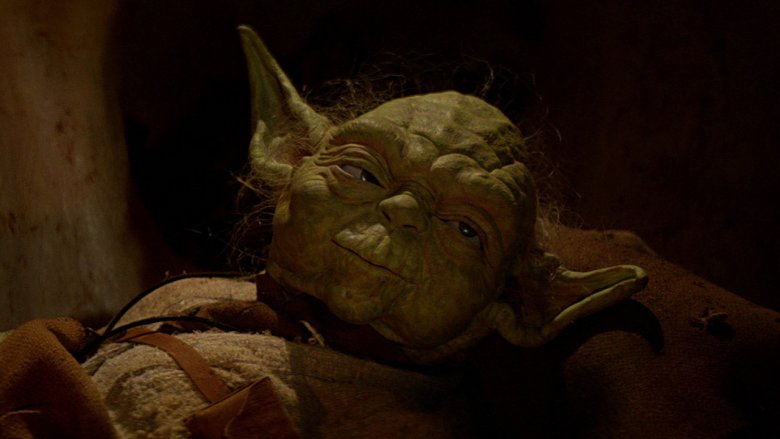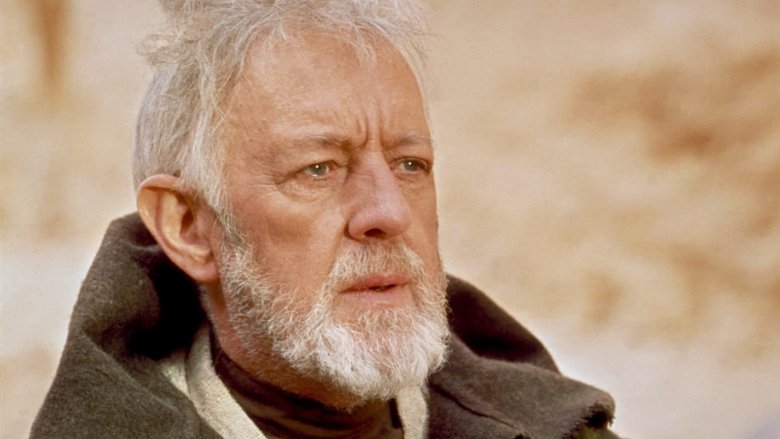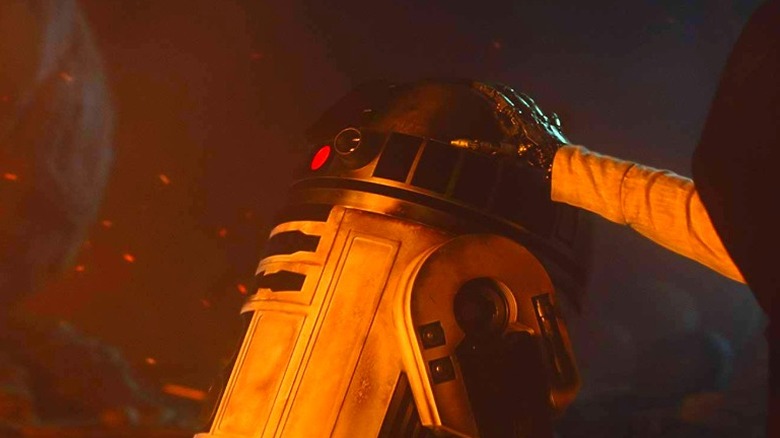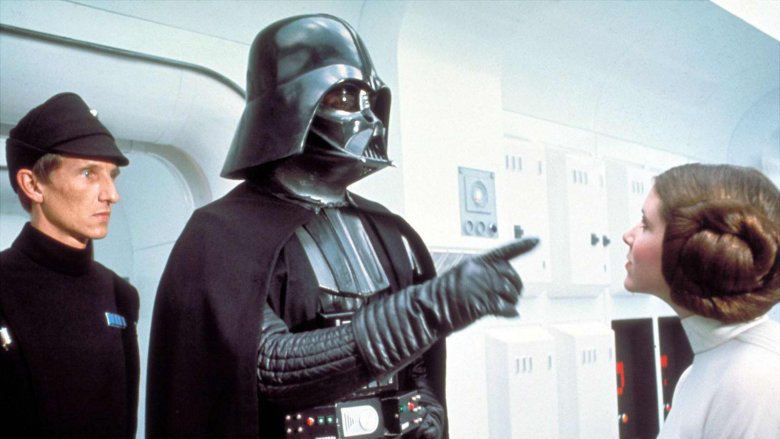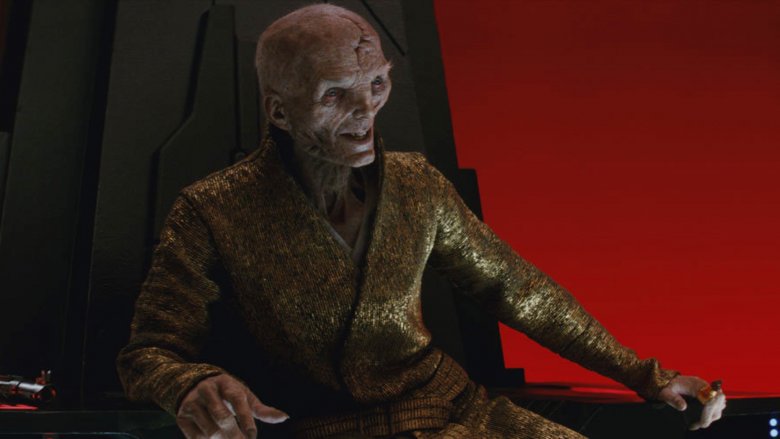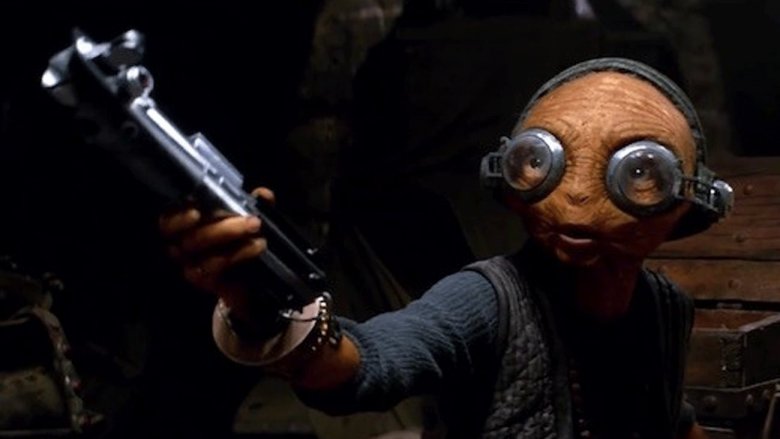Questions That Star Wars Movies Never Answer
The Star Wars saga began with one space opera adventure in 1977 and has since spread into a vast multimedia empire encompassing films, television, video games, comic books, novels, toys, and much more. For a great many fans, though, it still all boils down to what happens on the big screen. Yes, the die-hard fans will dig deeper into the lore in any way they can, but if you're just looking at Star Wars for its cinematic adventures, you're presented with a sprawling narrative with numerous side stories and loose threads that the films never have the time or the space to pick up and run with.
That means that, even if the expanded universe (both the non-canon old one and the new one under Disney) has taken the time to expand on things, the Star Wars films are absolutely packed with fascinating unanswered questions, some of which will never be addressed again. We've combed the Star Wars galaxy to find some of the most intriguing questions the Star Wars movies never seem to answer, from the origins of the Jedi to what exactly was up with R2-D2's silence.
How exactly was Anakin Skywalker conceived?
When Qui-Gon Jinn meets Anakin Skywalker and his mother, Shmi, he realizes quickly that the boy has certain prodigious gifts that make him a particularly promising future Jedi, and begins to ask Shmi about their family history. When asked about the boy's father, Shmi simply says "there was no father," leading to the conclusion that Anakin was somehow conceived by midichlorians, the microscopic entities that grant Force users their power to various degrees.
So... how does that work? Yes, knowing what we know about human biology this raises certain questions about Anakin's chromosomes and his own ability to eventually reproduce, but beyond that, how do midichlorians simply generate life on the level that they can actually get inside a woman and create a pregnancy? Of course, the films never dig far enough into this to clarify, and a Jedi biology lesson would have just slowed everything down.
Revenge of the Sith certainly drops some hints, as Palpatine shares with Anakin the story of the Sith Lord Darth Plagueis the Wise, who could manipulate the midichlorians to create life and taught his apprentice (clearly Palpatine himself) everything he knew. Palpatine's involvement was more explicitly spelled out in a Revenge of the Sith deleted scene and later a Marvel comic, but the movies themselves leave it a pointedly unanswered question.
How did Force manipulation become organized?
When we catch up with the galaxy in the very first Star Wars film, trained and adept Force users are few and far between thanks to the Jedi Purge and the rise of the Empire. The Jedi are relics of a bygone age, though Obi-Wan tells Luke of the thousand generations of the Knights who came before him, protecting the galaxy from the forces of the Dark Side.
The movies create the sense that use of the Force through either the Jedi or Sith traditions has been around for millennia, and that there are certain standard teachings on both sides that allow students to do everything from move objects with their minds to leap unnaturally high into the air. What the films don't tell us, even as the Jedi lore expands in the Disney era, is exactly how far back that history goes.
The Force is an innate, biological thing existing within everyone, but certain individuals are simply more naturally adept at channeling it. Who was the first person to realize that was a gift they could harness and train? Who decided to organize an entire lifestyle around it first? How did the tenets of the Jedi first take shape? There are certainly some answers to this in the Expanded Universe, but the films simply don't have the time to elaborate on it. Hopefully one day a film set in the distant past will be able to shed more light.
Where did the Chosen One prophecy come from?
The prequel trilogy is all about charting the rise and fall of Anakin Skywalker from boy with tons of potential to hotshot Jedi to Dark Lord of the Sith. That all begins with Qui-Gon Jinn's realization that Anakin — whose midi-chlorian ratings and natural talents seem off the charts — must be the Chosen One. When he relays his suspicions to the Jedi Council, Mace Windu brings up "the prophecy of the one who will bring balance to the Force." Yoda, Mace, Qui-Gon, and Obi-Wan Kenobi are all very aware of this prophecy, and Anakin's Chosen One narrative continues right up to the moment he loses his lightsaber duel with Obi-Wan in Revenge of the Sith.
So, the prequels are very clear that a prophecy exists and that it's well-known among Jedi Masters, but what the films don't make clear is exactly where the prophecy comes from. Who first articulated it? How long has it been around? Does every Jedi take it seriously or do a lot of them believe it's made-up hogwash that has no practical application when it comes to protecting the galaxy? And what does "bring balance to the Force" even mean when the Jedi believe that they've long-since defeated the Sith?
What's up with Yoda and Yaddle?
The original trilogy makes it a bit of a point to never explain much about Yoda, the enigmatic Jedi Master who lives on the swamp planet of Dagobah and even pretends he's not who he really is when he first meets Luke Skywalker, just to teach the young apprentice a lesson in expectation versus reality. All we really know about the little green guy in those original movies is that he's a Jedi Master, he taught Obi-Wan, and he can teach Luke. The mystery surrounding Yoda, combined with his unique appearance, led many fans to wonder what the master's backstory really was, and in particular if the alien species he belonged to would ever be revealed.
Then the prequels came along, and while we certainly learned more about Yoda's day job as the head of the Jedi Council, we still didn't learn much about his background. The mystery only deepened when The Phantom Menace introduced a second Jedi Master, Yaddle, who seemed to be of the exact same species, teasing some kind of connection that might pay off in a future film. It didn't, of course, and while there are certain supplemental stories you can dig up out there, Yoda remains a mysterious figure for many fans, and that's just the way they like it.
Wait, is Mace Windu alive?
The Star Wars films are full of famous death scenes that might not always be as final as they seem. The second film in the saga reveals that even after Obi-Wan Kenobi dies, he's able to come back as a Force ghost, something Yoda is also later able to do. The prequels have taken this a step further, with Solo: A Star Wars Story carrying on the story told in The Clone Wars TV series which revealed that the Sith Lord Darth Maul did not die when he was cut in half and thrown down a shaft by Obi-Wan Kenobi in The Phantom Menace. He somehow survived that fall and managed to get himself a sweet new pair of legs. But surely that can't be true for other Force using warriors who fell in the prequels... right?
As it turns out, maybe it can. In 2016, while answering fan questions via Twitter, Samuel L. Jackson declared "In my mind, I'm not dead" when referring to his character, Mace Windu, justifying his theory by citing the Jedi ability to fall from great distances and land safely. After all, we don't really see him dying in Revenge of the Sith, which does raise some questions when compared to all the other scenes in which we clearly watch Jedi getting cut down.
Speaking to Entertainment Weekly later, Jackson even said that he'd gotten his theory co-signed by George Lucas. "George is like 'I'm OK with that. You can be alive,'" Jackson said. So, if you believe Jackson, Mace Windu is still out there having one-armed Jedi adventures somewhere. What other Jedi might have made it out alive?
Why do only some Jedi vanish when they die?
The first time we see a Jedi Master die in A New Hope, Obi-Wan Kenobi simply vanishes when Darth Vader swings a lightsaber through his body. The second time we see a Jedi Master die in Return of the Jedi, Yoda quietly disappears from his sickbed. Both Jedi leave a pile of clothes in their wake but nothing else, something Luke Skywalker also did when he perished in The Last Jedi.
For a significant amount of time in Star Wars lore, you could have been forgiven for simply thinking that Jedi Masters vanish when they die, but that changed with The Phantom Menace, when Qui-Gon Jinn's body remained in place after his death, as did the bodies of numerous other Jedi during the Purge in Revenge of the Sith. So, why do some Jedi vanish and others don't? Is it based on their Force level? Do they train themselves to do that? Or is it simply that some choose to remove their own body from the mortal plane while others don't care?
The movies never explore this seeming inconsistency, but they almost did. Revenge of the Sith was set to reveal that the vanishing act had something to do with a discovery that Qui-Gon had made in the afterlife, but the scene was cut.
How does Obi-Wan choose what to admit and what to hide?
The longer you sit with the deeds and words of Obi-Wan Kenobi in the original Star Wars trilogy, the more frustrating some of his various decisions become. Yes, Obi-Wan saved Luke in a moment of crisis, gave him his heirloom lightsaber and started to teach him the ways of the Force. But he also seems to have been determined to obscure the truth as much as possible, particularly when it came to who Luke's father was. Obi-Wan obviously could have chosen to spill the beans right up front (or even at a later, more emotionally appropriate moment) that Luke's father was Darth Vader, but held off on that and instead said that Vader "betrayed and murdered your father."
Things get more complex when you start to factor in what Obi-Wan knew thanks to the events of the prequels, which reveal that he was not only there when Anakin Skywalker turned to Darth Vader, but also there when Luke and Leia were born, and there when the plan to separate and hide them was hatched. He also hung out with R2-D2 a whole hell of a lot. That Obi-Wan doesn't seem to acknowledge that Leia is Luke's sister ("That boy is our last hope," he tells Yoda) or remember R2-D2 just adds another layer of confusion to his thinking. There are reasons for some of it now, but there's a lot of head-scratching going on here.
Why doesn't R2-D2 speak up?
Perhaps no other character in all of the main Star Wars saga has been present for as many historic moments as R2-D2. Well, maybe C-3PO can compete with him, but unlike Artoo, Threepio had his mind wiped at the end of Revenge of the Sith, so he can't very well look at Darth Vader and realize, "Oh dear, that's my maker."
Artoo, on the other hand, has a memory packed with fascinating moments and galaxy-altering events, from the birth of the Skywalker twins to the turn of Anakin to the whole of the Clone Wars. He was there for all of it, and as far as we know from the films, he hasn't forgotten any of it. So why doesn't he speak up?
Seriously, the prequels retroactively add a ton of moments to the original trilogy where Artoo could have simply said, "Hey, she's your sister," or, "Hey, remember me? We hung out together during the Clone Wars." Even "Hey, that guy built you, Threepio" would have been relevant. Instead, he remains silent for reasons that are unknown to us. All we have are theories, and a hope that perhaps one day Artoo will break down and explain himself.
Why didn't Vader ever sense his daughter?
At the end of Revenge of the Sith, Bail Organa, Obi-Wan Kenobi, and Yoda have a conversation about the future of the Skywalker twins now that their mother, Padme Amidala, is dead. Obi-Wan says that the children should be hidden where the Sith cannot sense them, and Yoda declares that it's better to split them up and hide their relation to one another. Obi-Wan takes Luke to Tatooine to live with his aunt and uncle, while Leia goes with Bail Organa to Alderaan.
Roughly two decades later, during The Empire Srikes Back, Darth Vader begins to understand that he is in the presence of his long-lost son, and eventually tells Luke that he's his father. It makes sense that he might not have known it until then, particularly if he never made time in his busy Empire-building schedule to head back to Tatooine.
But what about Leia? When she and Vader cross paths in A New Hope, it's clear that they've known each other for some time, and he's aware of her skills as a leader. Why doesn't he ever seem to sense that she's his daughter? Is she somehow holding him off with her own limited use of the Force? Is he just dismissive of the very idea of it because she grew up so close to him? The films never make it clear, but Vader definitely had a closer connection with one twin than with the other.
How did Snoke come to power?
The sequel trilogy decided to keep up the Star Wars tradition of a shadowy figure pulling the strings of darkness by introducing Supreme Leader Snoke, a humanoid alien who, in The Force Awakens, only appears in the form of a giant hologram. That film gave us very little to go on about Snoke. All we really knew was the he led the First Order, he trained Kylo Ren, and he wanted to destroy Luke Skywalker and, by extension, the Jedi.
Though certain supplemental materials have since shed a little more light on Snoke, even The Last Jedi didn't give us much more information before unceremoniously slicing the Supreme Leader in half and ending his reign over the First Order. The Rise of Skywalker made things even more confusing with its reveal that Snoke was literally made in a tank by Palpatine.
We still have so many questions. Why was he a Dark Side Force user but not a Sith? How did he carve out the First Order from the remnants of the Empire in such a relatively brief period of time? The films might not ever tell us.
How did Maz Kanata get Luke's lightsaber?
In Star Wars: The Force Awakens we finally learn what happened to Luke Skywalker's first lightsaber, the one passed down to him by Obi-Wan Kenobi from his father, which he lost while dueling Darth Vader in Cloud City. Or at least, we learn part of what happened to it. The lightsaber was "locked away" in the possession of Maz Kanata at her castle on Takodana, but when Han Solo (who's known Maz for years) asks where she got it, Maz only answers that she's had it "for ages" and that the matter of how it came to her is "a good question, for another time."
In the context of The Force Awakens, Maz shrugs this question off because the First Order is attacking and the movie can't slow down to hear a big information dump about the lineage of a laser sword, but that hasn't stopped fans from wondering ever since exactly how Maz ended up with the lightsaber. Luke dropped it (along with his hand) on Bespin more than 30 years before, so how long are the "ages" in which it's been in Maz's possession? Why didn't she tell Han about it before? Did she have it even before Luke vanished, and if so, why didn't she try to give it back to him?
